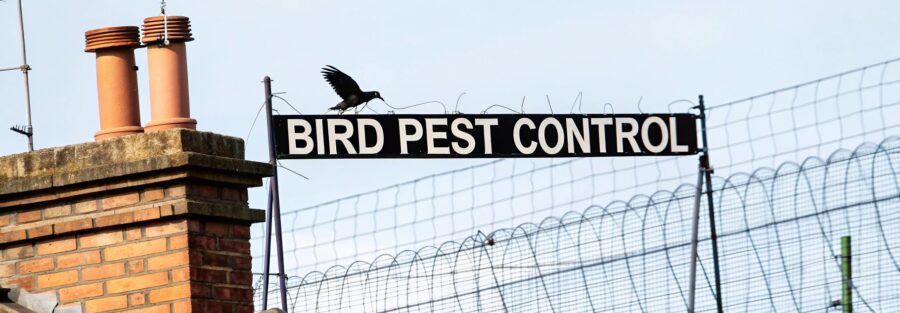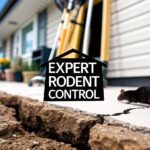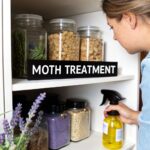Effective bird pest control always starts with two crucial things: knowing exactly which species you're dealing with and understanding your legal responsibilities. Different birds cause very different problems, and the solutions have to be both targeted and lawful to protect wildlife and your property.
Identifying Common UK Bird Pests and Legal Duties
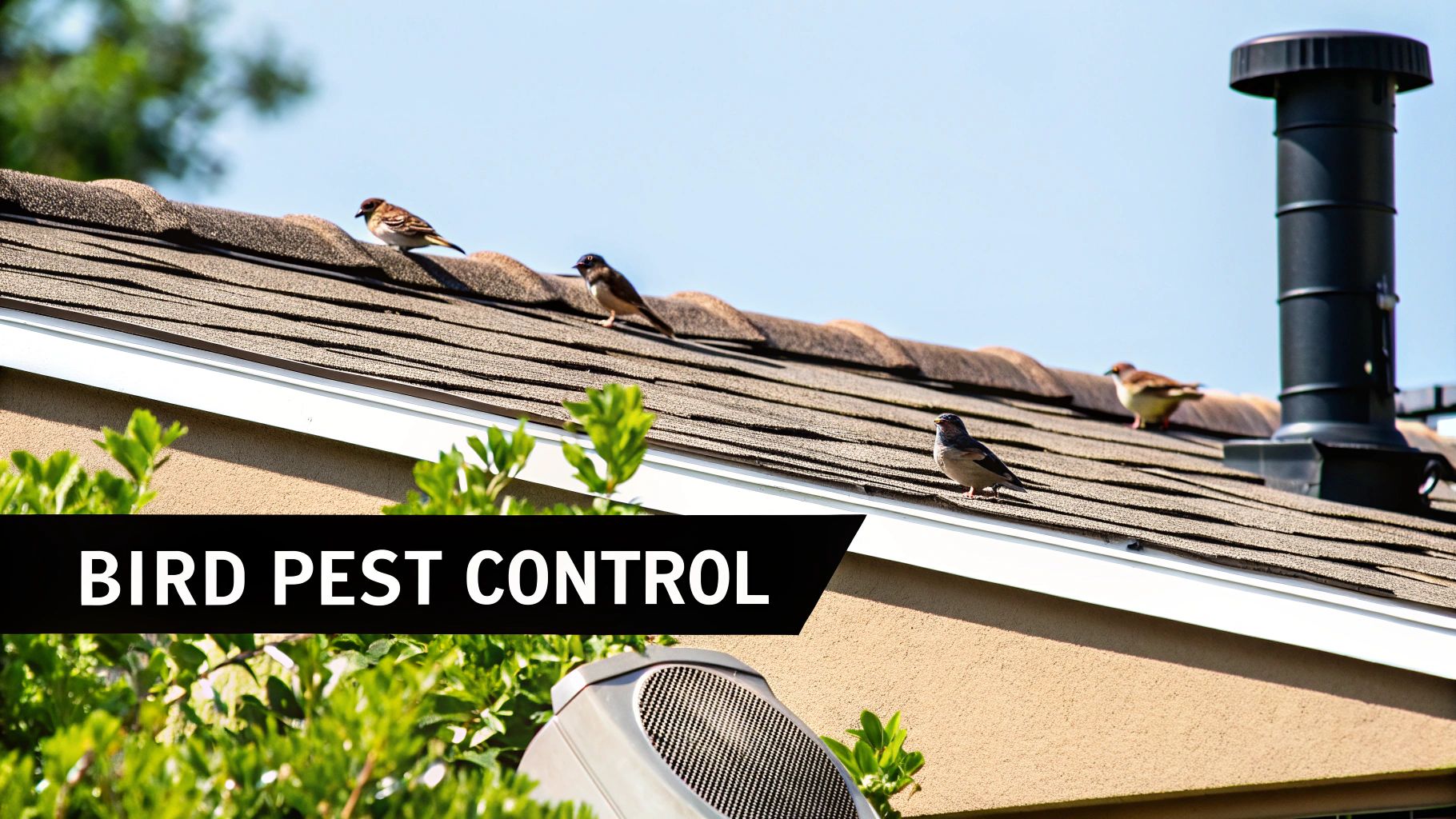
Before you can even think about a control strategy, you need to know what you’re up against. The UK has several bird species that can become a real nuisance in both urban and rural settings, each with its own habits and risks. Figuring out the culprit is the only way to find a humane and effective solution.
The most common offenders we see are feral pigeons, gulls, and starlings. Pigeons, for example, are infamous for fouling buildings. Their acidic droppings don't just look awful; they cause permanent damage to stonework, metal, and paintwork. They love to shelter on ledges, balconies, and increasingly, under solar panels, creating a huge mess and a lot of noise.
Gulls, especially herring gulls and lesser black-backed gulls, are no longer just a seaside problem—they’re a common sight in inland cities, too. They can be incredibly aggressive during their nesting season, and their large, messy nests are notorious for blocking gutters and chimneys, which often leads to water damage.
The Damage They Cause
A bird infestation is far more than a minor annoyance. The consequences can be seriously costly and hazardous, impacting your property, health, and general safety. When you understand the specific risks, it becomes clear why professional bird pest control is often a necessary investment.
Key problems include:
- Structural Damage: Bird droppings contain uric acid, a corrosive substance that eats away at materials like stone, concrete, and metal over time. Nesting debris can also block up drainage systems, causing leaks and significant water damage.
- Health Hazards: Fouling isn't just unsightly; it can harbour dangerous pathogens like Salmonella and fungi that cause diseases such as Histoplasmosis.
- Equipment Malfunction: Nests built inside machinery, air conditioning units, or ventilation systems can lead to blockages, create serious fire hazards, and result in expensive repairs.
- Reputational Damage: For any business, a visible bird problem can drive customers away. It creates an impression of an unhygienic, poorly maintained environment, which is especially damaging in the food and hospitality industries.
To help you quickly identify the birds causing issues on your property, here’s a quick-reference table.
Common UK Bird Pests and Their Associated Risks
| Bird Species | Primary Risks to Property | Health Concerns |
|---|---|---|
| Feral Pigeon | Acidic droppings corrode stone and metal; nests block gutters and drains; can damage solar panels. | Droppings can carry diseases like Ornithosis and Salmonella; nesting material can harbour mites. |
| Herring Gull | Aggressive behaviour during nesting season; large nests block chimneys and gutters, causing water damage. | Can spread harmful bacteria like E. coli through fouling; aggressive behaviour can cause injury. |
| Starling | Large flocks create immense noise and mess; acidic droppings damage buildings; nests can be a fire hazard. | Fouling can lead to fungal infections like Histoplasmosis; they can carry mites and fleas. |
| House Sparrow | Nests in roof voids and machinery, creating fire risks and blocking ventilation systems. | Droppings can contaminate food sources and surfaces with bacteria. |
Understanding these risks is the first step, but it's crucial to act within the law when addressing them.
Understanding Your Legal Obligations
This is the most critical part of bird pest control in the UK: you must comply with the law. All wild birds, their nests, and their eggs are protected under the Wildlife & Countryside Act 1981. It is illegal to intentionally kill, injure, or take any wild bird, or to damage or destroy an active nest, without the correct licence.
This legal framework is there for a very good reason. Many of our native bird populations are under serious pressure. Since detailed counts began, the UK has lost a staggering 54% of its house sparrow population and 84% of its starlings. These declines are often linked to habitat loss and a reduction in insect populations, a vital food source. You can learn more about the factors affecting UK insect populations and the knock-on effect on wildlife.
The law allows for control measures under specific general licences, but only for certain species and for clear reasons, such as preserving public health or safety. Using humane, professional methods isn't just best practice; it is a legal requirement.
Failing to follow these regulations can lead to severe penalties, including hefty fines and even imprisonment. Any action you take must be justified, proportionate, and carried out using approved methods. This is precisely why calling a professional pest control service is so important—we understand the legal complexities and ensure any action taken is fully compliant. Distinguishing between a few visiting birds and a genuine infestation is key to knowing when intervention is both necessary and legally allowed.
Your First Line of Defence: Proactive Prevention
When it comes to bird pest control, the best approach isn't chasing them away after they've settled in. It's about making your property an unwelcome stop in the first place. A smart, proactive strategy focuses on taking away the very things that attract birds, encouraging them to simply fly on by. This way, you save yourself the time, money, and hassle of dealing with a full-blown infestation down the line.
It all boils down to a bird's basic needs: food, water, and shelter. If you can methodically remove their access to these essentials, you create an environment where nuisance birds just can't get comfortable. It's a simple idea, but it's the foundation of any truly effective pest management plan.
Remove Potential Food and Water Sources
Birds are opportunists. An easy meal is like a flashing neon sign inviting them to stick around. So, the first thing you need to do is walk around your property and look for potential food and water sources, then get rid of them. You'd be surprised what a difference a few small changes can make.
Start with the obvious stuff. Make sure all your outdoor rubbish bins have lids that fit snugly. Pigeons and gulls are masters at raiding open or overflowing bins, so you have to be consistent. In the same vein, don't leave pet food bowls outside for hours on end – it's a guaranteed free meal for any bird in the area.
Beyond those basics, think about these points:
- Clean Up Spills Immediately: A spillage at a commercial loading bay or some dropped chips in a pub garden is a feast for birds. Cleaning it up quickly cuts off their food supply.
- Be Smart with Bird Feeders: If you love feeding garden birds, that's great. Just make sure your feeders are designed to keep out larger pests like pigeons. Look for ones with weight-activated perches or cages that only let smaller birds in.
- Get Rid of Standing Water: Birds need to drink, too. Puddles on flat roofs, gutters clogged with leaves, or even a forgotten plant saucer full of rainwater are all prime drinking spots. Improving drainage and keeping gutters clear removes this key resource.
By focusing on these small but crucial details, you are disrupting the very ecosystem that allows a pest population to establish itself. Prevention is always more effective and humane than dealing with an infestation after the fact.
This proactive mindset is at the heart of modern pest control. In fact, professional strategies are built on this very principle. You can see how it works by exploring the core ideas behind Integrated Pest Management. It’s all about prioritising prevention and changing the environment rather than just reacting to a problem.
Conduct a Thorough Property Audit
Once you’ve tackled food and water, your next target is shelter. Birds are always on the lookout for a safe, protected spot to roost and build a nest. Unfortunately, your building might offer dozens of perfect locations without you even realising it, from sheltered ledges to hidden gaps in the roof. A detailed property audit helps you spot these weak points and secure them before they become a problem.
Start at ground level and do a full lap of your building. Keep your eyes peeled for any potential entry points. Look for gaps in the brickwork, broken air bricks, and any openings where pipes or cables enter the building. Even a tiny gap can be enough for starlings or sparrows to squeeze through.
Now, look up. Your roofline is prime real estate for nesting birds.
- Eaves and Soffits: Check for any gaps or holes where the roof meets the walls. Birds love these dark, sheltered spots for nesting.
- Lofts and Attics: Make sure any vents are covered with a sturdy mesh and that there are no broken tiles creating an easy way in.
- Under Solar Panels: This is a big one. The space between solar panels and the roof is warm, dry, and safe from predators—a perfect nesting site. Professional bird proofing for solar panels is often essential.
Blocking these entry points is non-negotiable. Sealing gaps with wire mesh, installing bird spikes on ledges, and using specialist solar panel proofing can make your property bird-proof. It's also worth noting that bird activity can cause other issues; exploring practical advice like these 5 tips to prevent roof leaks is a smart move, as nests and droppings often lead to blockages and water damage.
Make Smart Landscaping Choices
Believe it or not, your garden can either attract nuisance birds or help keep them away. Making strategic choices with your landscaping can make your property much less appealing to pests without ruining its look.
Tree branches that hang over your roof are like a personal bridge for birds, giving them easy access. Keep them trimmed well back from the building to remove this route. It’s a simple bit of maintenance that can stop birds from finding a convenient spot to scope out your roof for nesting opportunities.
Also, think about what you’re planting. If you have a problem with pigeons or starlings, it’s probably not a good idea to plant fruit-bearing trees and shrubs right next to your building. While supporting local wildlife is a wonderful thing, a massive, reliable food source can quickly lead to an unmanageable pest problem. The aim is to create a balanced garden that doesn't encourage huge flocks to take up residence.
Choosing the Right Physical Bird Deterrents
When being proactive just isn’t enough to keep determined birds at bay, physical barriers are your best bet. They offer a humane, effective, and lasting solution. The goal isn't to harm the birds; it’s simply to make it impossible or uncomfortable for them to land, roost, or nest on your property.
A successful bird pests control strategy is all about denying access to those desirable spots. We're essentially changing the building's environment to make it unsuitable for birds, encouraging them to find a new home elsewhere. This is a much more sustainable approach than scare tactics, which birds eventually learn to ignore.
This image highlights just how much of an impact a bird infestation can have on a property, making effective control essential.
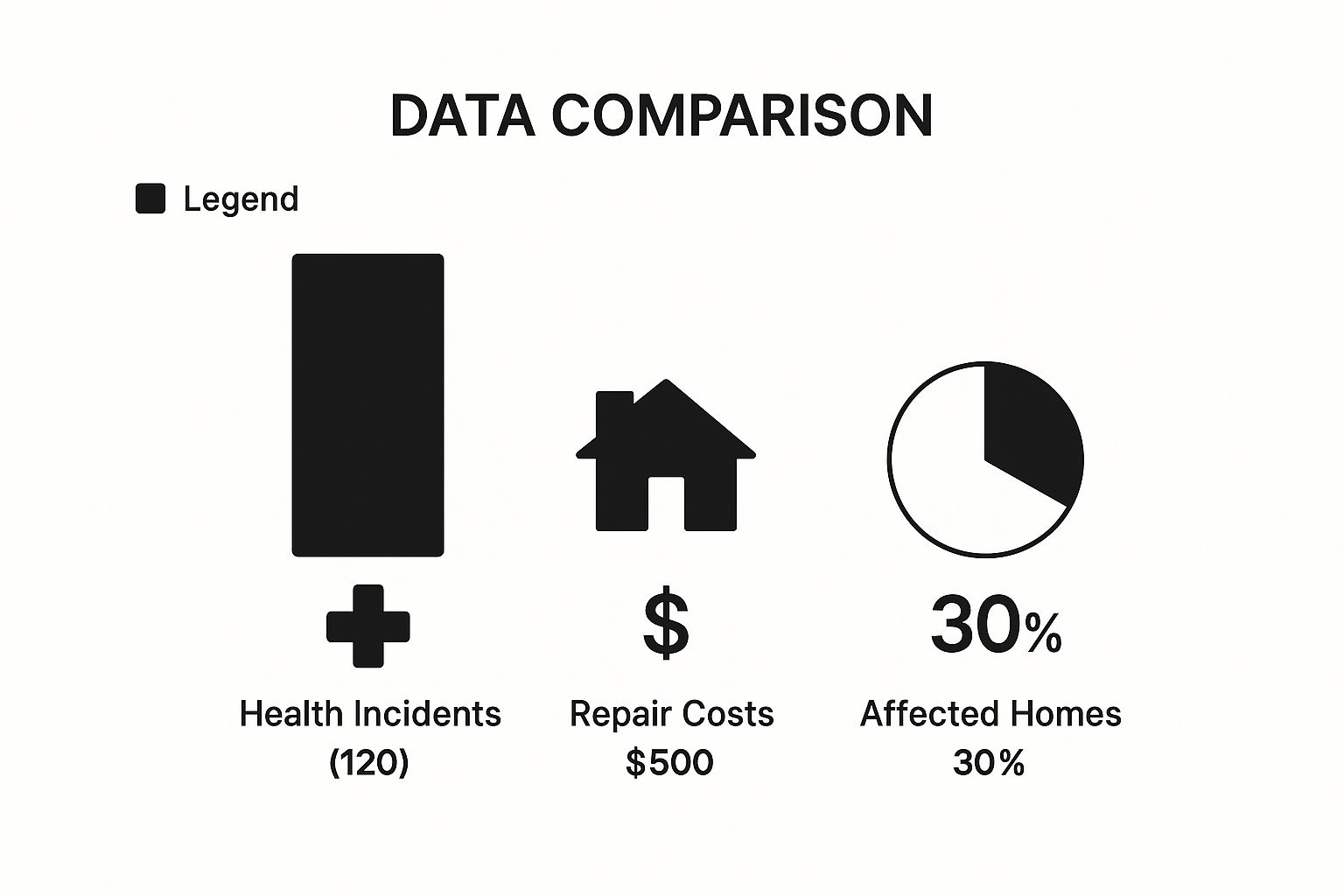
As you can see, the issues go far beyond a simple annoyance. Bird problems can lead to serious health incidents, expensive repairs, and affect a surprising number of homes.
Bird Netting For Total Exclusion
Bird netting is one of the most effective physical deterrents out there because it creates a complete barrier. When it's installed correctly, it completely excludes birds from specific areas. This makes it our go-to solution for protecting balconies, light wells, building facades, and large open areas like loading bays.
The secret to effective netting is a professional installation. A poorly fitted net with gaps or sags won't work and can even be a danger to wildlife. We use a tensioned wire rope system around the perimeter to get the net drum-tight, leaving no room for birds to sneak through or get trapped.
Netting is the perfect choice for:
- Protecting Balconies: For city flats, a discreetly installed net can reclaim a pigeon-covered balcony without ruining the view.
- Securing Loading Bays: In commercial properties, netting stops birds roosting in the rafters and fouling products or vehicles below.
- Guarding Rooftop Machinery: We can use netting to enclose air conditioning units and other equipment, preventing nesting that leads to damage.
Getting the mesh size right is also crucial. We typically use a 19mm mesh for sparrows, 50mm for pigeons, and 75mm for gulls. A proper survey will tell us exactly what your situation requires.
Anti-Perching Spikes and Post-and-Wire Systems
For narrow surfaces like ledges, parapets, pipes, and signs, anti-perching spikes are the industry standard. They consist of stainless steel spikes set in a polycarbonate base, and they work by making it physically impossible for birds to get a comfortable landing. Despite how they look, they're designed to be a humane deterrent and don't harm the birds.
Placement is everything. Spikes have to cover the entire depth of the ledge to be effective. Leave even a small gap, and birds will just land behind them, making the whole system useless.
For properties where looks are a top priority, like listed or historic buildings, a post-and-wire system is a fantastic alternative. It’s a very discreet solution that uses thin, spring-tensioned stainless steel wires held up by small posts.
The wires create an unstable landing surface that birds can't stand, encouraging them to move on without affecting the building's architectural look. From the ground, these systems are often almost invisible.
This makes post-and-wire the perfect choice for ornate stonework, delicate window sills, and prominent ledges where visible spikes would just look wrong.
Comparing Physical Bird Deterrent Methods
Choosing the right physical deterrent comes down to your specific needs, property type, and budget. To help you understand the options at a glance, we've put together a simple comparison of the most common methods used across the UK.
| Deterrent Type | Best For | Discreetness Level | Typical Cost |
|---|---|---|---|
| Bird Netting | Large areas like balconies, courtyards, loading bays | Medium | ££ |
| Bird Spikes | Ledges, parapets, pipes, signs | Low to Medium | £ |
| Post-and-Wire | Historic buildings, window sills, ornate ledges | High | £££ |
| Bird Slopes | 90-degree ledges, beams | High | ££ |
| Electric Tracks | High-profile buildings, statues, signs | Very High | ££££ |
Each system has its place. While spikes are cost-effective for straightforward ledges, a post-and-wire system preserves the aesthetics of a delicate structure. A professional assessment will always identify the most suitable and effective solution for your property.
Advanced Structural Modifications
Sometimes, we need to go a step further with solutions that are integrated right into the building. These methods modify the structure itself, blending in seamlessly while offering robust, long-term bird pests control.
One really clever solution is the bird slope. These are angled, slippery PVC panels we install on ledges to create a surface that birds just can't grip. Any bird that tries to land will slide right off. They work wonders on 90-degree ledges and are a low-maintenance, permanent fix.
Another advanced option is a low-profile electric shock track. These systems give a mild, harmless electric shock when a bird lands on them—similar to the static you might get from a carpet. The jolt is startling but not painful, and it quickly teaches birds to stay away. They are extremely discreet and ideal for high-profile buildings where other methods would be too obvious.
Finally, never forget that birds will exploit any opening they can find. It's vital to seal potential entry points around your property. Installing robust mesh air brick covers is a simple but essential step to stop smaller birds from getting into wall cavities and nesting, which can cause huge problems.
Using Sensory Deterrents: Sight and Sound
While physical barriers are the gold standard for a long-term fix, clever sensory deterrents play a huge role in a solid bird pests control strategy. These methods are all about tapping into a bird's natural survival instincts—their fear of predators and dislike for confusing or threatening environments. By using sight and sound, you can make an area feel unsafe, encouraging birds to find somewhere else to hang out, all without any physical contact.
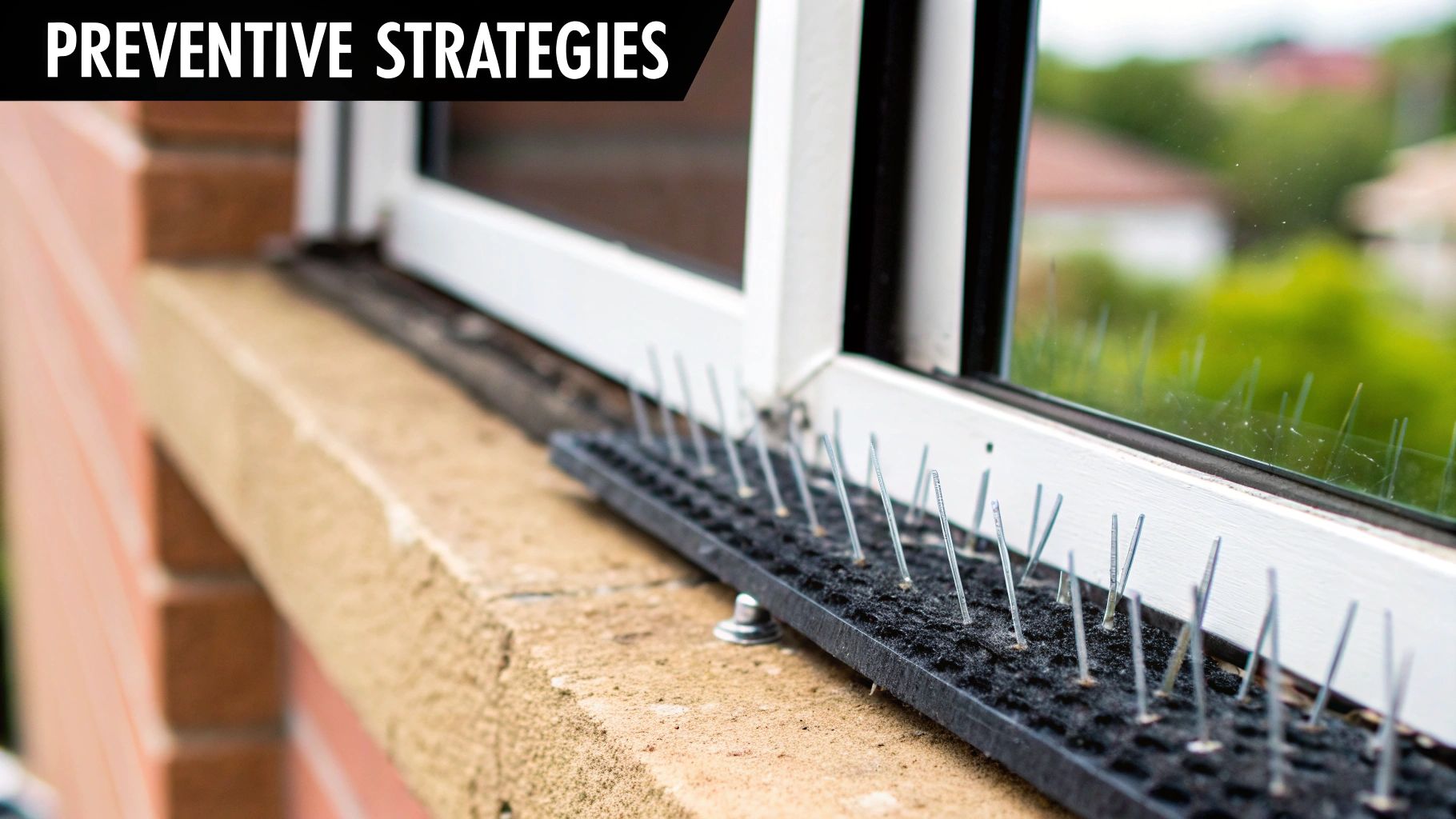
The trick with sensory deterrents is remembering that birds, especially pigeons, are surprisingly clever. They can quickly learn that a static threat isn’t real. Because of this, you need to actively manage these methods and change things up frequently to keep them working.
Capitalising on Visual Threats
Visual deterrents are designed to do one of two things: mimic a predator or create disorienting flashes of light that birds can't stand. They’re often inexpensive and dead simple to set up, making them a great first port of call for smaller-scale issues, like keeping a few persistent birds off a balcony or out of a garden.
One of the most common tools we see is reflective tape, sometimes called scare tape. This holographic ribbon flashes erratically in the sun and makes a crinkling sound in the wind, hitting them with a double-whammy of sight and sound disturbance. For the best effect, hang short strips from tree branches, along railings, or above seating areas where they can move freely and catch the light.
Then there's the classic predator decoy—think plastic owls or hawks. The idea is spot on, but their success hangs entirely on how you use them.
A stationary owl decoy will be completely ignored by local pigeons within a day or two. To make decoys work, you have to move them to a new, prominent spot every couple of days. This simulates a real, active predator hunting in the area.
For a slightly different approach, scare-eye balloons can be surprisingly effective. These are brightly coloured, inflatable balls with large, intimidating eye patterns printed on them. The "eyes" look like those of a large predator, and as the balloon bobs around in the wind, it creates the illusion of a living threat. Just tie them to a post or tree branch where they have room to move.
The Power of Unsettling Sounds
Auditory deterrents are the other half of the sensory puzzle. These devices create an environment that's either annoying or genuinely frightening to birds, persuading them to leave. They range from simple noise-makers to more advanced electronic systems.
The simplest options often work like reflective tape but focus on sound. Wind chimes or other items that create sudden, unpredictable noises can sometimes do the job. For a more targeted approach, however, electronic devices offer far more control and effectiveness in your bird pests control efforts.
Ultrasonic Devices
These gadgets emit high-frequency sound waves that we can't hear but are incredibly irritating to many bird species. The idea is to create a constant, annoying background hum that makes an area totally unpleasant for them to stick around in.
- Best for: Semi-enclosed spaces like warehouses, loading bays, or balconies where the sound can be contained and concentrated.
- The catch: Their effectiveness drops off in wide-open areas, as the sound waves dissipate quickly. Walls and other solid objects can also block the frequencies.
Bio-Acoustic Systems
For a much more sophisticated solution, bio-acoustic systems broadcast the actual distress calls of specific bird species, along with the calls of their natural predators (like hawks and falcons). Hearing these sounds triggers a deep, instinctual response in pest birds, warning them that danger is right here, right now.
This method is particularly powerful against flocking birds like starlings or gulls. When they hear what sounds like one of their own in trouble, their immediate reaction is to get out of there fast. Modern systems are often programmable, letting you vary the sounds, timing, and volume to stop the birds from getting used to the warnings.
Combining a visual deterrent, like a hawk decoy, with a bio-acoustic system playing falcon calls can create a seriously powerful and convincing illusion of danger. Remember, the goal isn't just to scare birds once, but to create a consistently threatening environment that persuades them to set up their territory somewhere else entirely.
Understanding Health Risks and Safe Cleanup
A bird infestation is much more than just an eyesore or a noise complaint; it’s a real public health hazard. The mess birds leave behind isn't just unsightly—it's a breeding ground for nasty pathogens that can pose serious risks to people. This is why proper bird pests control isn't just about removal, but also understanding the dangers and having a solid plan for safe remediation.
Bird droppings, often called guano, and old nesting materials can harbour over 60 different transmissible diseases. When this stuff dries out, it becomes an airborne dust that anyone nearby can easily breathe in. Suddenly, a seemingly minor pigeon problem on a balcony or a starling infestation in a loft becomes a significant health and safety issue for your family, employees, or customers.
Common Diseases Linked to Bird Fouling
These risks aren’t just theoretical—they're well-documented public health challenges. Some of the worst illnesses are caused by fungal spores and bacteria that flourish in bird droppings. Leaving an accumulation of fouling allows these pathogens to multiply, increasing the risk of exposure with every passing day.
Three of the most significant diseases you should know about are:
- Histoplasmosis: This is a respiratory disease you can get from inhaling fungal spores that grow in bird droppings. Symptoms can be anything from a mild flu-like illness to severe lung infections, especially for people with weaker immune systems.
- Cryptococcosis: Another fungal disease that starts as a lung infection after breathing in spores from dried droppings. It has the potential to spread to other parts of the body, including the brain, where it can lead to a serious condition called cryptococcal meningitis.
- Salmonellosis: Most of us link this bacterial infection to food poisoning, but the bacteria can also be present in bird droppings. Dust from the fouling can easily contaminate work surfaces, food prep areas, and even water sources.
These dangers are exactly why you can't just sweep the problem away with a broom. The cleanup has to be handled with extreme care.
The Ongoing Threat of Avian Influenza
On top of the usual bacterial and fungal risks, it’s vital to be aware of viral threats like Avian Influenza. The UK has been dealing with ongoing challenges from Highly Pathogenic Avian Influenza (HPAI), a serious disease in birds that requires strict biosecurity measures.
Since October 2024, Great Britain has seen numerous outbreaks in domestic poultry where HPAI H5N1 was confirmed. At the same time, over 600 wild birds tested positive for HPAI, nearly all of them the H5N1 strain. The government's risk assessment reflects this ongoing threat, making professional bird pests control and cleanup more critical than ever. You can get a deeper understanding by exploring the latest official reports on Avian Influenza.
While the virus rarely jumps directly to humans, the fact that HPAI is present in the wild bird population means we must take a cautious, professional approach to handling any bird-related waste. It's all about minimising every possible risk.
Your Guide to Safe Cleanup Procedures
Cleaning up bird fouling and nesting materials is a hazardous job. It demands the right gear and a methodical approach to get it done safely. Whatever you do, never dry-sweep or pressure-wash dried droppings. This will only send dangerous spores and bacteria into the air you breathe.
For a safe cleanup, you must have the correct Personal Protective Equipment (PPE):
- Respiratory Protection: A respirator with a P3 filter is non-negotiable. It's essential for stopping you from inhaling airborne particles. A simple dust mask just won't cut it.
- Protective Clothing: Disposable coveralls, gloves, and boot covers are needed to stop contaminants from getting onto your skin and everyday clothes.
- Eye Protection: Safety goggles are a must to protect your eyes from contaminated dust and any cleaning solutions.
The cleanup process itself has to start by dampening the affected areas with a good virucidal disinfectant. This neutralises the pathogens before you try to remove anything, preventing dust from becoming airborne. Once the material is saturated, it can be carefully scraped up, double-bagged securely, and disposed of as hazardous waste according to your local council’s regulations.
When to Call a Professional Bird Control Service
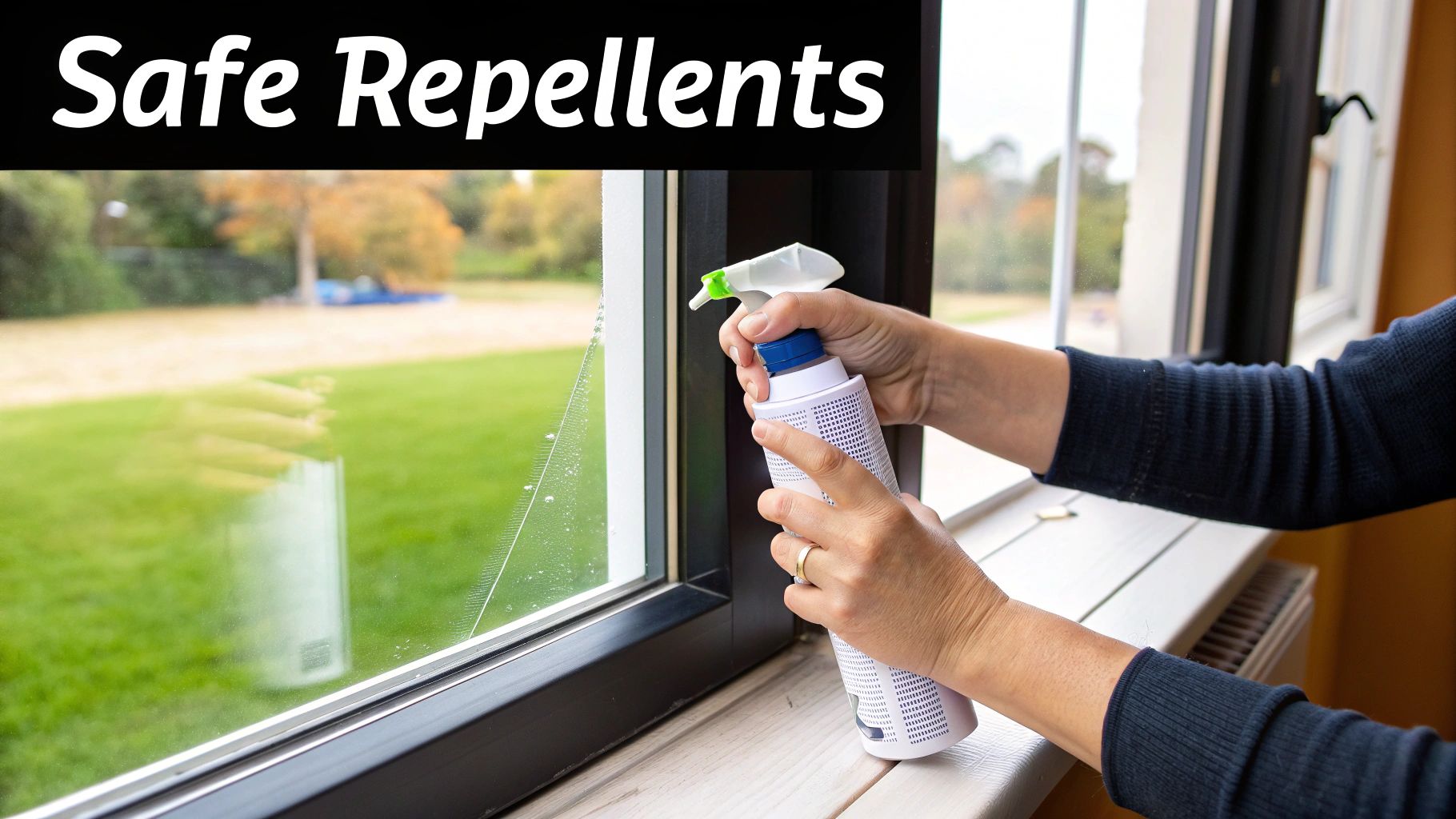
While many small-scale bird issues can be managed with a bit of DIY effort, there are definite times when trying to tackle the problem yourself is impractical, unsafe, or just plain ineffective. Knowing when to put down the home-made deterrents and pick up the phone to a professional is the key to protecting your property and getting a real, lasting solution.
The most obvious sign? The sheer scale of the problem. If you’re facing a huge, well-established flock of pigeons taking over a commercial roof, or dozens of starlings have moved into your loft, simple spikes or gels just won’t cut it. These situations require a strategic, multi-pronged attack that only an experienced team can really deliver.
High-Risk and Inaccessible Locations
One of the clearest red flags is where the birds are nesting. They often pick high or difficult-to-reach spots like church spires, ledges on multi-storey buildings, or complicated roof structures. Trying to get to these areas without the right training and safety equipment is incredibly dangerous.
Professionals have the correct gear, from scaffolding to access platforms, and the certifications needed to work safely at height. It’s not just about getting the job done—it's about doing it without putting anyone at risk, a non-negotiable part of health and safety.
Beyond just height, some situations demand specialist knowledge right from the start. Think about scenarios like these:
- Nests near machinery: Birds nesting in ventilation systems or near electrical units are a serious fire hazard.
- Aggressive birds: Gulls, in particular, can get extremely aggressive when protecting their young during nesting season. Trying to move them can easily lead to injury.
- Protected species: A pro can identify the bird species correctly and make sure all control measures comply with the Wildlife & Countryside Act 1981, avoiding hefty fines.
The Value of Professional Expertise
Bringing in a certified technician isn't just about convenience; it’s an investment in a guaranteed, long-term fix. A professional will conduct a proper risk assessment, pinpointing not just the current issue but also spotting weaknesses that could lead to future problems. It’s much like how a business might use professional health and safety consulting to manage workplace risks—a bird control expert does the same for your building.
They know exactly which deterrents work for specific species and building types, ensuring the solution is both effective and discreet. After a few failed DIY attempts, many property owners find that calling in a professional is actually the more economical choice in the long run.
By investing in a professional service, you are paying for peace of mind. You get the assurance that the issue will be resolved safely, legally, and with a lasting guarantee that a DIY approach simply cannot match.
A reputable company also handles the hazardous clean-up of droppings and nesting materials, which protects you from the serious health risks they carry. For a full picture of the options available, it's always a good idea to explore the range of professional pest control services to find the best approach for your specific situation. Making that call protects not just your property, but your well-being too.
Got Questions About Bird Pests? We’ve Got Answers.
Tackling a bird problem can bring up a lot of questions. From what you’re legally allowed to do, to whether that plastic owl you bought is actually working, getting the right advice is key. Here are some of the most common queries we get from property owners across the UK.
Is It Legal to Remove a Bird's Nest?
This is one of the first things people ask, and the answer is usually no. Under the Wildlife & Countryside Act 1981, all wild birds, their eggs, and their nests are protected by law. It’s illegal to deliberately damage or destroy an active nest, so timing and professional guidance are absolutely critical.
Control measures are only permitted under specific general licences for certain pest species, like pigeons, and only when there’s a real reason—such as protecting public health and safety. This is exactly why you need a professional assessment before taking any action.
Which Bird Control Method Is the Most Effective?
Honestly, there’s no single "best" method. The right solution always depends on the situation. The species of bird, the part of the building they’ve taken over, and the type of structure all play a huge role in what will work.
- For large, open spaces like loading bays or balconies, bird netting is often the gold standard because it creates a complete physical barrier.
- For ledges, sills, and parapets, you can’t go wrong with anti-perching spikes. They’re a cost-effective and reliable way to stop birds from landing.
- For listed or historic buildings where looks matter, a discreet post-and-wire system is usually the go-to choice.
The most bulletproof solutions often combine a few different methods. For instance, we might install spikes on the most prominent ledges while using netting to protect a recessed balcony area. This creates a layered defence that covers all the bases.
Are DIY Bird Deterrents a Waste of Money?
DIY fixes like scare tape or a plastic owl can sometimes work for a minor, temporary issue. They might be enough to convince a few pigeons to leave your garden for a little while. However, for an established infestation, they are rarely a permanent fix.
Birds, especially pigeons, are smart. They quickly learn that a decoy that never moves or a bit of flashing tape isn't a real threat—this is a process called habituation. A professional bird pests control service offers durable, guaranteed solutions designed for the long haul. It might seem like a bigger outlay at first, but it’s far more cost-effective than wasting money on temporary tricks that just don’t last.
If you're dealing with a persistent bird problem and need a solution that works, Pest Predators Limited is here to help. Our team uses proven, evidence-based methods to protect your property safely and legally. Contact us today for a professional assessment.

